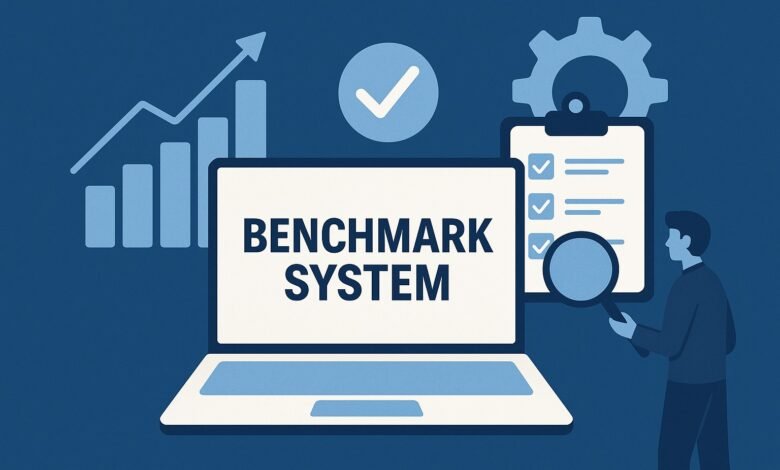Benchmark System – Redefining Performance Standards for Modern Businesses

Introduction: The Power of a Benchmark System in Modern Business
In today’s rapidly changing digital landscape, businesses can no longer rely solely on intuition or outdated metrics to measure success. Every decision—from infrastructure investments to operational strategies—needs to be backed by real-time data and performance standards. This is where a 跑分系统 plays a transformative role.
A Benchmark System enables organizations to set measurable standards, analyze performance, and implement optimization strategies that lead to sustained growth. Whether it’s used in financial systems, IT infrastructure, supply chain management, or human resource performance, the Benchmark System provides a unified framework for comparison and improvement.
This comprehensive guide explores how a Benchmark System redefines performance standards for modern businesses, the technologies that make it possible, and how it drives continuous innovation across industries.
Understanding What a Benchmark System Is
A Benchmark System is a structured analytical framework that measures, evaluates, and compares performance metrics against predefined standards or industry best practices. It helps businesses identify strengths, uncover inefficiencies, and discover opportunities for improvement.
At its core, a Benchmark System is not just about data—it’s about insights. It converts complex data into actionable intelligence that can influence decision-making at every organizational level.
Key Components of a Benchmark System:
- Performance Metrics – Quantifiable measures such as speed, cost-efficiency, uptime, or productivity.
- Comparative Database – A centralized collection of historical or external benchmarks.
- Data Analytics Engine – AI-driven algorithms that process and interpret data.
- Reporting Dashboard – A visual interface that displays performance insights in real time.
- Feedback Loop – A mechanism that continuously refines benchmarks based on evolving business needs.
A robust Benchmark System aligns internal goals with market realities, ensuring that every department contributes to overall business excellence.
The Evolution of Benchmark Systems in Business
Benchmarking has existed for decades, but modern Benchmark Systems represent a technological leap. In the early 2000s, benchmarking involved manual data collection, static spreadsheets, and delayed reporting. Today, it’s an automated, intelligent, and predictive process.
Modern Benchmark Systems integrate with ERP platforms, CRM systems, and cloud databases to provide real-time analytics. They utilize AI and machine learning to predict performance trends, flag inefficiencies, and recommend strategic adjustments.
The digital transformation of benchmarking has turned it from a reactive process into a proactive tool for innovation. Businesses no longer wait for performance to decline—they act in advance, guided by predictive insights from their Benchmark System.
Why Every Modern Business Needs a Benchmark System
Businesses today face intense competition, shrinking margins, and rising customer expectations. A Benchmark System helps them stay ahead by delivering clarity and precision in performance measurement.
Core Benefits of a Benchmark System:
- Improved Decision-Making
Data-driven insights from the Benchmark System empower managers to make smarter, faster, and more strategic choices. - Cost Optimization
By revealing inefficiencies, the Benchmark System helps reduce waste and allocate resources effectively. - Enhanced Productivity
Continuous monitoring through a Benchmark System ensures that teams meet or exceed performance expectations. - Risk Reduction
Predictive analysis helps identify potential operational or financial risks before they escalate. - Competitive Advantage
A business using a Benchmark System always knows where it stands compared to competitors, allowing it to adapt quickly to market shifts.
With these benefits, it’s clear that a Benchmark System is not a luxury—it’s a necessity for any business aiming to thrive in 2025 and beyond.
Types of Benchmark Systems Used by Businesses
Different industries and business models require tailored benchmarking approaches. Below are the major types of Benchmark Systems in use today.
- Internal Benchmark System
Compares performance across departments or branches within the same organization. Ideal for identifying internal best practices.
- Competitive Benchmark System
Analyzes data against competitors to understand market position and identify potential advantages.
- Functional Benchmark System
Focuses on specific functions like marketing, finance, or operations to improve efficiency.
- Strategic Benchmark System
Examines long-term strategies, market positioning, and innovation initiatives.
- Process Benchmark System
Looks at specific workflows—such as order fulfillment or customer onboarding—to improve accuracy and speed.
Each Benchmark System type serves a unique purpose, but together, they provide a 360° view of business performance.
Implementing a Benchmark System: Step-by-Step Guide
Adopting a Benchmark System requires thoughtful planning and structured execution. Here’s a practical guide:
- Define Objectives – Identify what needs to be measured—efficiency, cost, customer satisfaction, or innovation.
- Select Metrics – Choose KPIs that align with strategic goals.
- Collect Data – Use automated systems, sensors, and cloud integrations to gather accurate data.
- Analyze and Compare – Run comparisons using historical data or industry benchmarks.
- Implement Changes – Apply insights to optimize performance and productivity.
- Monitor Continuously – Use the Benchmark System dashboard for ongoing evaluation and adjustment.
This process ensures that benchmarking is not just a one-time project but a continuous improvement cycle.
The Role of Technology in Benchmark Systems
Technology is the driving force behind the modern Benchmark System. With AI, machine learning, IoT, and cloud computing, benchmarking has evolved into a powerful, automated, and scalable process.
AI-Powered Insights
Artificial intelligence analyzes vast amounts of data in real time, identifying patterns that human analysts might overlook.
Cloud-Based Infrastructure
Cloud integration ensures scalability and accessibility, enabling businesses to access their Benchmark System data anytime, anywhere.
IoT Integration
IoT sensors provide real-time performance data from machines, logistics, and production environments.
Predictive Analytics
Predictive modeling in Benchmark Systems helps forecast trends, risks, and opportunities.
Through these innovations, a Benchmark System becomes a living framework—constantly learning, adapting, and evolving with the business.
How the Benchmark System Enhances Financial Performance
One of the most significant benefits of a Benchmark System is its impact on financial management.
It provides CFOs and financial analysts with key insights into cost structure, profit margins, and ROI. For instance, a Benchmark System can identify which branches generate the highest returns, which vendors offer the best deals, or where operational costs can be reduced.
Additionally, the Benchmark System promotes transparency and accountability by offering verifiable financial data that supports audit and compliance requirements.
Benchmark System in Operations and Supply Chain
For manufacturers, logistics providers, and retailers, operational efficiency is critical. The Benchmark System allows companies to track metrics such as production downtime, delivery times, and inventory accuracy.
By comparing these metrics to industry standards, the Benchmark System identifies performance gaps and suggests corrective measures. Over time, this leads to streamlined operations, reduced waste, and improved customer satisfaction.
The Human Factor: Benchmark Systems and Workforce Optimization
While automation and analytics are central to any Benchmark System, the human element remains essential.
A well-designed Benchmark System motivates employees by setting clear, achievable performance targets. It also provides transparent feedback, helping individuals understand how their contributions align with company goals.
Through fair evaluation and performance tracking, the Benchmark System fosters a culture of accountability and continuous learning.
Challenges in Benchmark System Implementation
Despite its benefits, implementing a Benchmark System comes with challenges:
- Data Quality Issues – Inaccurate data leads to misleading results.
- Resistance to Change – Employees may feel threatened by constant monitoring.
- Cost of Integration – Setting up an advanced Benchmark System requires investment.
- Overdependence on Technology – Human oversight remains crucial to interpret data correctly.
Successful businesses overcome these obstacles by promoting transparency, providing proper training, and emphasizing that the Benchmark System is a tool for growth—not surveillance.
Case Study: Real-World Application of Benchmark Systems
A leading logistics company implemented a Benchmark System across 15 global hubs. Within six months, they observed:
- 18% reduction in delivery delays
- 22% improvement in fuel efficiency
- 30% increase in employee productivity
The Benchmark System allowed the company to compare metrics across regions, identify best-performing hubs, and replicate successful practices across the organization.
This case illustrates how a well-integrated Benchmark System can drive measurable performance improvements across complex operations.
The Future of Benchmark Systems: AI, Blockchain, and Beyond
The next generation of Benchmark Systems will integrate emerging technologies like blockchain for secure data sharing and AI for autonomous optimization.
- Blockchain Integration ensures data integrity and transparency across organizations.
- AI-Augmented Benchmarking offers self-learning systems that adapt metrics dynamically.
- Cross-Industry Collaboration will create unified benchmarking databases for shared growth.
In the future, the Benchmark System will not just measure performance—it will predict, optimize, and innovate autonomously.
How a Benchmark System Builds Trust and Credibility
Trust is a cornerstone of modern business. By using a Benchmark System, companies can demonstrate accountability to investors, clients, and regulators. Transparent performance metrics build confidence, attract partners, and enhance brand reputation.
In industries like fintech, healthcare, and manufacturing, regulatory compliance often requires proof of performance standards. A Benchmark System provides that verifiable proof, reinforcing integrity and professionalism.
Integrating Benchmark Systems into Sustainability Goals
In 2025 and beyond, sustainability is not optional—it’s expected. A Benchmark System can track environmental KPIs such as carbon emissions, energy efficiency, and waste management.
By aligning these metrics with sustainability goals, companies can report progress confidently and demonstrate environmental responsibility.
This integration of business performance with ecological benchmarks ensures long-term resilience and brand value.
Conclusion: Redefining Success Through Benchmark Systems
The 跑分系统 has evolved from a simple comparison tool into a cornerstone of strategic decision-making. It empowers organizations to measure, improve, and innovate continuously.
In a world defined by data and digital transformation, businesses that embrace the Benchmark System gain a clear competitive edge. They don’t just meet performance standards—they redefine them.
From finance to operations, from sustainability to human resources, the Benchmark System ensures that every part of an organization contributes to its overall excellence.
As technology continues to evolve, the future belongs to businesses that leverage the Benchmark System as their guiding framework—turning data into direction and performance into progress.





